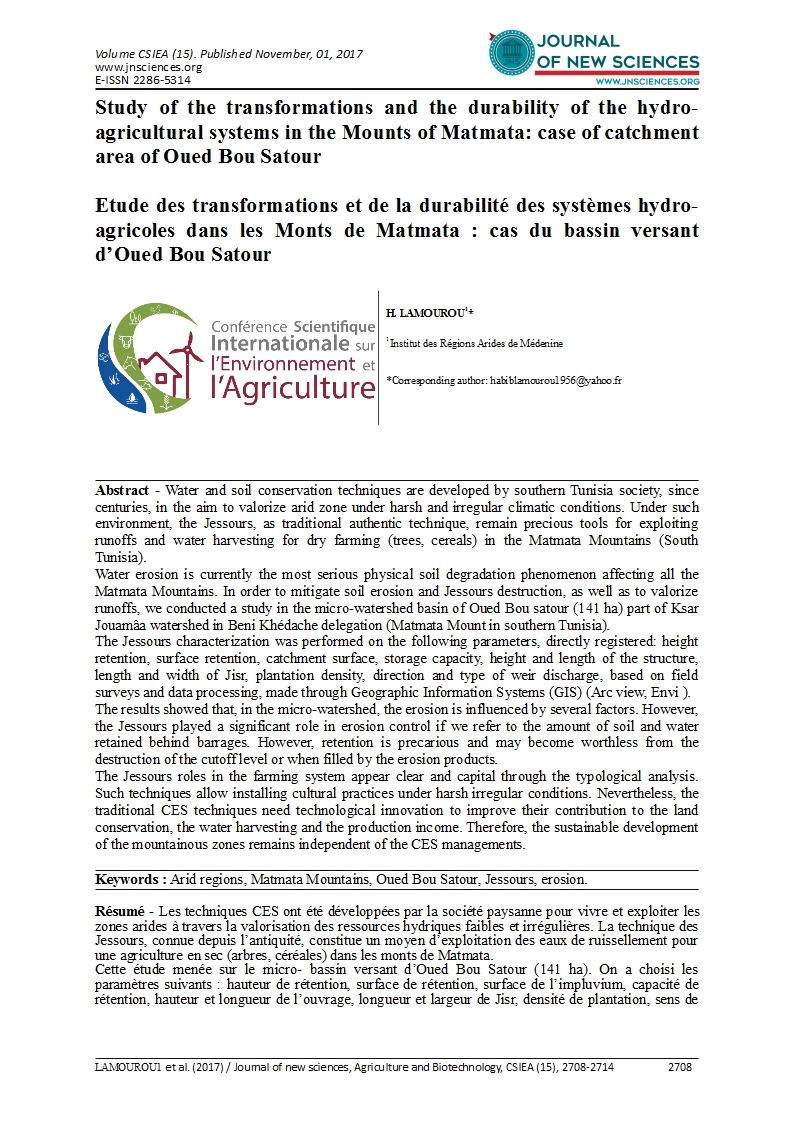

- Category: Volume spécial (Conférence CSIEA 2017)
- Hits: 6667
Study of the transformations and the durability of the hydro-agricultural systems in the Mounts of Matmata: case of catchment area of Oued Bou Satour
Etude des transformations et de la durabilité des systèmes hydro-agricoles dans les Monts de Matmata : cas du bassin versant d’Oued Bou Satour
|
|
H. LAMOUROU1*
1Institut des Régions Arides de Médenine |
Abstract - Water and soil conservation techniques are developed by southern Tunisia society, since centuries, in the aim to valorize arid zone under harsh and irregular climatic conditions. Under such environment, the Jessours, as traditional authentic technique, remain precious tools for exploiting runoffs and water harvesting for dry farming (trees, cereals) in the Matmata Mountains (South Tunisia). Water erosion is currently the most serious physical soil degradation phenomenon affecting all the Matmata Mountains. In order to mitigate soil erosion and Jessours destruction, as well as to valorize runoffs, we conducted a study in the micro-watershed basin of Oued Bou satour (141 ha) part of Ksar Jouamâa watershed in Beni Khédache delegation (Matmata Mount in southern Tunisia). The Jessours characterization was performed on the following parameters, directly registered: height retention, surface retention, catchment surface, storage capacity, height and length of the structure, length and width of Jisr, plantation density, direction and type of weir discharge, based on field surveys and data processing, made through Geographic Information Systems (GIS) (Arc view, Envi ). The results showed that, in the micro-watershed, the erosion is influenced by several factors. However, the Jessours played a significant role in erosion control if we refer to the amount of soil and water retained behind barrages. However, retention is precarious and may become worthless from the destruction of the cutoff level or when filled by the erosion products. The Jessours roles in the farming system appear clear and capital through the typological analysis. Such techniques allow installing cultural practices under harsh irregular conditions. Nevertheless, the traditional CES techniques need technological innovation to improve their contribution to the land conservation, the water harvesting and the production income. Therefore, the sustainable development of the mountainous zones remains independent of the CES managements.
Keywords : Arid regions, Matmata Mountains, Oued Bou Satour, Jessours, erosion.
Résumé - Les techniques CES ont été développées par la société paysanne pour vivre et exploiter les zones arides à travers la valorisation des ressources hydriques faibles et irrégulières. La technique des Jessours, connue depuis l’antiquité, constitue un moyen d’exploitation des eaux de ruissellement pour une agriculture en sec (arbres, céréales) dans les monts de Matmata. Cette étude menée sur le micro- bassin versant d’Oued Bou Satour (141 ha). On a choisi les paramètres suivants : hauteur de rétention, surface de rétention, surface de l’impluvium, capacité de rétention, hauteur et longueur de l’ouvrage, longueur et largeur de Jisr, densité de plantation, sens de déversement et type de déversoir ; en se basant sur les relevés de terrain et les traitements des données effectués par des logiciels (SIG), (Arcview , Envi ). Cette étude a montré que, dans le micro-bassin versant d’Oued Bou Satour, l’érosion est influencée par une multitude des facteurs. Le rôle joué par les Jessours dans la lutte antiérosive n’est pas négligeable si on se réfère aux quantités de sol et d’eau retenus derrière les barrages. Toute fois cette rétention est précaire et peut devenir nulle dès la destruction du seuil de rétention, ou son comblement par les produits de l’érosion. L’installation des Jessours a permis l’installation d’un système d’exploitation agricole. Les résultats de l’enquête réalisée aux près 25 exploitants ont montré l’importance du système Jessours dans la lutte contre l’érosion hydrique et la dégradation des sols et par la suite le maintien d’une agriculture locale plus au moins durable.
Mots clés: Régions arides, Monts des Matmata, Oued Bou Satour, Jessours, érosion.

